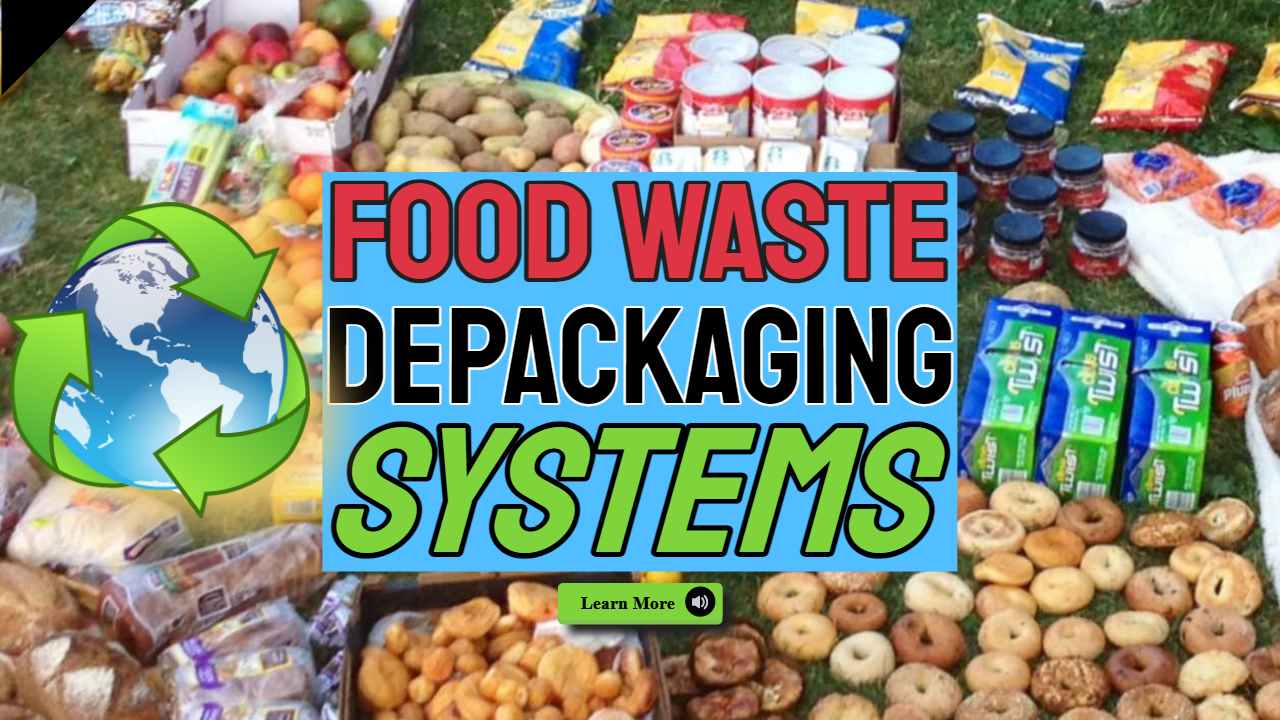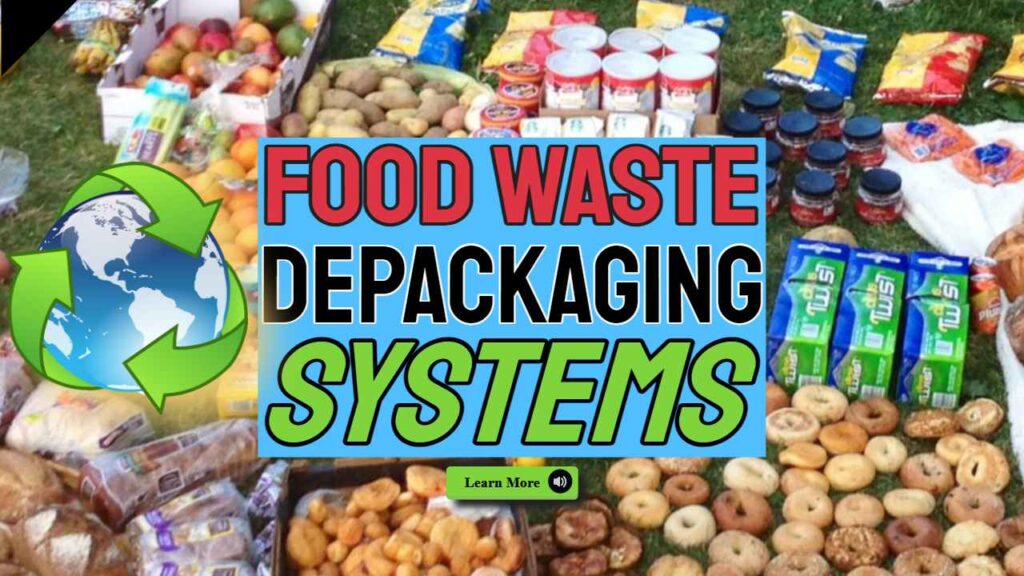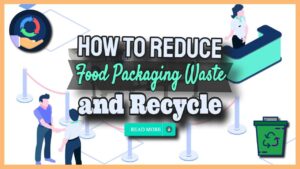The Best Food Waste Depackaging Systems Don’t Hammer
In this post, we show why the best food waste depackaging technologies available today do not smash the packaging into shreds, and there is no doubt that this is an important point to recognise given the increasing importance of food waste avoidance and processing.
A growing number of food waste depackaging methods are also suitable for non-source-separated biodegradable municipal refuse (BMW). The tendency presently is to expand organic waste recycling to ever-increasing percentages in an effort to help avert global warming. This makes sense in order to prevent this material from ending up in landfills and to satisfy the COP26 obligations made by so many countries to decarbonize their economies.
Regardless of how well-trained employees are in food waste source separation, the purity of source-separated organics (SSO) will always be less than perfect, and in some cases significantly less. It's unrealistic to expect lazy individuals to think twice before tossing their plastic bottles, wrappers, and anything else they don't want into food trash containers. As a result, there must now be a significant investment in automated gear to sort out the mess created when various types of packaging and debris are tossed into food waste receptacles.
Packaging is mechanically separated from biological trash in these systems. The packaging is gathered and fed through a compactor before being disposed of or recycled, as appropriate. Organic garbage is collected in tankers and dumped straight into a landfill, biogas plant, or composted in facilities.
The best Food Waste Depackaging Systems reliably and swiftly separate organic from non-organic packing materials, such as plastics and paper. They are suitable for turning trash from the food processing sector, retail and restaurant waste streams, and other recyclable food items into a profitable, value-added product.

Separation and Depackaging Machines
The first job of de-packaging machines and related separation equipment is to:
Produce a pure organic output with the consistency of pulp or a thick soup, as well as a reject stream that is as clean and devoid of water as feasible.
Although the amount of packaging in the reject stream will vary, the bulk of food waste and mechanically separated organic content, such as BMW (also known as OFMSW), will contain a large amount of plastic in some form.
Reducing Water in the Output Streams
It is critical to avoid the presence of moisture in the reject stream because moisture-laden content invariably contains calorific organic material, which every biogas plant or compost facility operator wants to see in the pulp where it produces biogas – the plant operator’s source of profit.
Depackaging machines remove the outside packing (wrappings) from the contents inside the food box, package, tin, drum, sacket, and so on, allowing biological waste to be collected or recycled rather than disposed of in landfills. Food waste reduction is becoming increasingly important among enterprises and local governments all over the world.
Even source-separated food waste cannot be directly fed into the biogas generation process/biogas digester due to the amount of plastic present. Plastic packaging is constantly present, whether discarded by homeowners or catering establishments and if allowed to persist, it will have a negative impact on digestion.
Before entering a digester tank, all packaging containers must be opened, and the water content of both the pulp and the rejects (plastics and other items) must be low. All of these parameters must be met in order for appropriate food waste material to enter an anaerobic digestion plant's digester tanks. Although plastic separation after digestion was prevalent in the past, it should be phased out.
Types of Food Waste Depackaging Systems
Food waste depackaging systems are available in a variety of configurations, with some using a hammermill and others utilising a shredding machine. Others utilise paddles, while others use a squashing and squeezing motion. The spectacle of depackaging is evocative of the early days of automobiles.
To begin with, each model of car was distinct. Motor cars steadily became more identical until now, when technological advancement has taken us to the point where each car has a combustion engine and the same foot pedals, steering wheel, and clutch. One day, the repackaging business will be the same, however, for the time being, the systems used vary widely.
Disadvantages of the “Smash Everything Up” Hammer Mill Approach
A hammermill expends a great deal of energy in breaking and smashing everything into small pieces. The revolving hammers break apart all materials in the food waste packaging, leaving just the organic content to be strained out. The only problem is that the final mash contains a lot of microplastic because everything has been broken down so finely. This is the hardest type of plastic to sort and reprocess, and it is also the most destructive to the environment and wildlife in particular.
Food Waste Depackaging Machines
One significant element of depackaging machines, in our opinion, should be that they do not rely on the technique found in early equipment. Size reduction should no longer be considered acceptable due to the environmentally dangerous action of increasing microplastic content, which is likely to wind up in the environment, at least in part.
Equipment for depackaging food waste should be intended to do the opposite of breaking things up small. It should use a range of attributes and less severe forces to open packages. The centrifuge's alternating tensile and compressive forces, as well as vortex action and a few revolving paddles, are utilised in the most modern types of this equipment to crack open the containers.
These forces can work together to separate solids and liquids (for example restaurant waste). The use of these different characteristics and switches in a food waste depackaging machine can also boost the efficiency of later AD plants and IVC (In-vessel Composting) operations.
The image's text reads, “Food Waste Depackaging Systems.”
Packaging with Less Fragmentation
The latest generation of multi-action food waste depackaging devices is designed to eliminate fragmented packing. The rotating paddles and flails help break apart the parcels. Empty packages are transported along the upper side of the processing chamber by flails and paddles, and rejects can be discharged out the output point using water or air.
If your composting facility handles similar garbage, these machines may be well worth the investment because they can cut contamination removal expenses while also opening up new tipping revenue prospects for industrial food product depackaging and recycling.
More resilient packing, such as jars of honey sealed in plastic containers inside a cardboard box, will be completely depackaged as the horizontal or vertical processing chamber advances the incoming material down the length. To depackage food waste, a turbo or vortex separator does not require the addition of water.
SSO Energy Recovery is a term that has a lot of different meanings depending on who you ask.
The process of transforming non-recyclable waste materials and packaging into useable energy such as heat, electricity, or fuel is known as energy recovery from municipal waste. This can be performed using a variety of processes, including combustion, gasification, pyrolysis, anaerobic digestion, and landfill gas recovery.
Cleanaway's Separator Machine
The latest food waste depackaging device from Cleanaway separates liquid and organic debris for anaerobic digestion. The rotating cylinder at the centre of the machine opens and moves the packages along and out of the chamber's top using paddles. If the packaging is long-lasting, it will be repackaged by splitting, and vibration in some machines helps remove tough dried-and-burnt-on food.
This is an option for processing huge amounts of packaged food, especially restaurant garbage. Depackaging machines provide a wide range of capabilities, are small in size, and require little maintenance. The method helps to recover precious organic materials.
The Cleanaway plant in Victoria processes ten tonnes of packaged food waste every hour. The equipment is capable of recovering up to 99 per cent of the material. The equipment does not process the glass. The procedure is carried out in a separate chamber, where the packing is broken by squeezing. Following separation, the leftover components are disposed of by anaerobic digestion. This technology reduces carbon dioxide and methane emissions while conserving landfill areas. If you have a repackaging unit, it will be the most efficient way to recycle your packaging.
Scott's Instruments
The food waste depackaging machines from Scott Equipment include a horizontally structured chamber with rotating paddles and flails. These revolving blades shred the package at 400 rpm. The SSO Model is a horizontally organised machine that uses a hammer to open empty packages. These devices are offered in two capacities. The larger machine can treat source-separated organics and BMW at a lower flow rate than the smaller plant, which has a capacity of 40 tonnes.
The Dominator, which separates plastic containers and plastic bottles from the contents of the containers and bottles, is another brand taking on the subject of better waste depackaging.
Other Separation and Depackaging Machines
It can be difficult to keep food products out of landfills, especially because many meals are carefully wrapped. Some pots and punnets are quite little, while others might be quite enormous.
A number of food waste depackaging devices employ a hammer and subsequently a screw press to remove the pulp and particles from packaged goods. To pick and sort the incoming objects, every depackaging machine type may use a combination of physical material characteristics in addition to a hammer. A hammermill, for example, can be fed by a counter-rotating dual-auger mixing/feeding hopper and the output (fibres) separated by a horizontal or vertical-pressure screw press.
It may break the package with a single characteristic while emptying the packages with a different set of selectors.
Twister Depackager by Drycake
Drycake's Twister uses a variety of properties to separate the recyclable organic component. While this may appear to be hard, it is essential for proper recycling. To depackage all types of food packaging, the most versatile machines use different combinations of these variables.
Separated packaging can subsequently be delivered to a recycling facility or sold as RDF, resulting in even more waste reduction and the possibility of generating additional revenue streams.
This machine is capable of depackaging a wide range of wet and dry waste materials, including food, pharmaceutical, and municipal garbage, as well as tetra packs, tin cans, and plastic bottles.
Tiger Machine
The Tiger machine is a well-known food waste depackaging equipment. It could be the start of the Alzheimer's disease process. Many reference sites in the UK use the Tiger, which is supported by its UK distributor, Blue Group. Tiger machine components are available for same-day or next-day delivery.
There are significant gaps between the requirement for machine maintenance or repair and its ability to be operated by a team of personnel, with training available in any language.
Conclusion on Food Waste Depackaging Systems
Food waste depackaging machinery is used to separate the solid organic material from the packing. The best equipment can also be utilised to distinguish between BMW and OFMSW.
There has been a shift away from lowering the particle size of incoming food waste and toward less harmful approaches that attempt to avoid the formation of microplastics. The most recent technology attempts to retain film bags and packets as entire and intact as possible. While expelled things are frequently incomplete, they are normally in many fragments rather than pulverised into unidentifiable shreds and flakes.
Modern equipment uses a range of selection qualities and characteristics to separate the organic fraction. Without adequate depackaging and separation, the organic material cannot be removed. Food waste depackaging machines are crucial for the plastic recycling industry because plastic packing cannot be recycled without these devices. These devices are not only beneficial to the AD process, but they also assist IVC composting facilities in accepting packaged food.
With the latest technology, the process can be more simplified, require less labour to manage this equipment, and be more efficient. At the same time, the new equipment is environmentally friendly. Here is a comprehensive list of food waste depackaging and separation equipment suppliers.
https://www.rinobs.com/food-waste-depackaging-systems .
The post The Best Food Waste Depackaging Systems Don’t Hammer appeared first on https://stop-global-warming.co.uk
The post The Best Food Waste Depackaging Systems Don’t Hammer appeared first on https://gqcentral.co.uk




